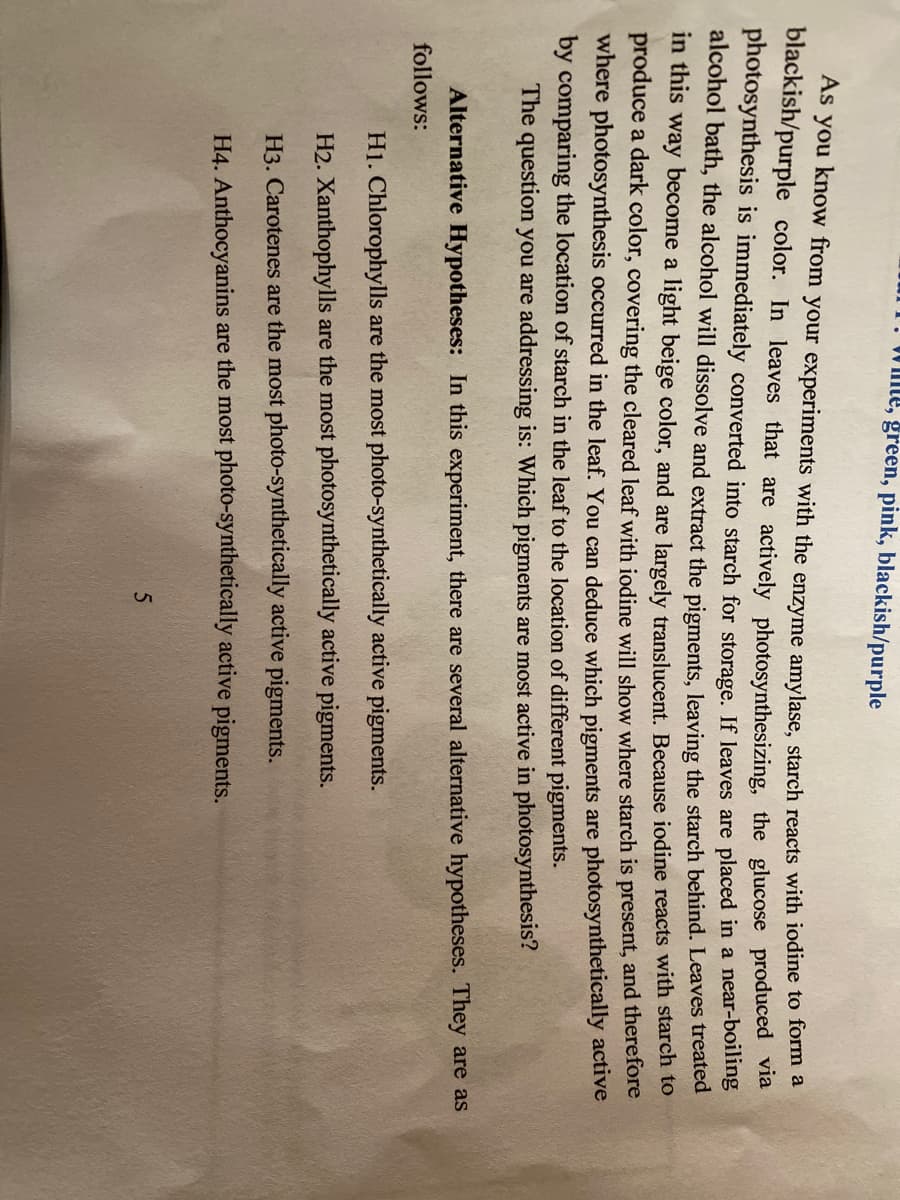I am trying to figure out these four things. What is the independent variable, what is the dependent variable, what are the controlled variables and why this experiment doesn’t use a control.
I am trying to figure out these four things. What is the independent variable, what is the dependent variable, what are the controlled variables and why this experiment doesn’t use a control.
Biochemistry
6th Edition
ISBN:9781305577206
Author:Reginald H. Garrett, Charles M. Grisham
Publisher:Reginald H. Garrett, Charles M. Grisham
Chapter21: Photosynthesis
Section: Chapter Questions
Problem 5P: The Relative Efficiency of ATP Synthesis in Noncyclic versus Cyclic Photophosphorylation If...
Related questions
Question
I am trying to figure out these four things.
What is the independent variable, what is the dependent variable, what are the controlled variables and why this experiment doesn’t use a control.

Transcribed Image Text:Vte, green, pink, blackish/purple
As you know from your experiments with the enzyme amylase, starch reacts with iodine to 1omm a
blackish/purple color. In leaves that are actively photosynthesizing, the glucose produced Via
photosynthesis is immediately converted into starch for storage. If leaves are placed in a near-bolinng
alcohol bath, the alcohol will dissolve and extract the pigments, leaving the starch behind. Leaves treated
in this way become a light beige color, and are largely translucent. Because iodine reacts with starch to
produce a dark color, covering the cleared leaf with iodine will show where starch is present, and therefore
where photosynthesis occurred in the leaf. You can deduce which pigments are photosynthetically active
by comparing the location of starch in the leaf to the location of different pigments.
The question you are addressing is: Which pigments are most active in photosynthesis?
Alternative Hypotheses: In this experiment, there are several alternative hypotheses. They are as
follows:
H1. Chlorophylls are the most photo-synthetically active pigments.
H2. Xanthophylls are the most photosynthetically active pigments.
H3. Carotenes are the most photo-synthetically active pigments.
H4. Anthocyanins are the most photo-synthetically active pigments.
Expert Solution
This question has been solved!
Explore an expertly crafted, step-by-step solution for a thorough understanding of key concepts.
This is a popular solution!
Trending now
This is a popular solution!
Step by step
Solved in 2 steps

Knowledge Booster
Learn more about
Need a deep-dive on the concept behind this application? Look no further. Learn more about this topic, biochemistry and related others by exploring similar questions and additional content below.Recommended textbooks for you

Biochemistry
Biochemistry
ISBN:
9781305577206
Author:
Reginald H. Garrett, Charles M. Grisham
Publisher:
Cengage Learning

Biology: The Unity and Diversity of Life (MindTap…
Biology
ISBN:
9781305073951
Author:
Cecie Starr, Ralph Taggart, Christine Evers, Lisa Starr
Publisher:
Cengage Learning


Biochemistry
Biochemistry
ISBN:
9781305577206
Author:
Reginald H. Garrett, Charles M. Grisham
Publisher:
Cengage Learning

Biology: The Unity and Diversity of Life (MindTap…
Biology
ISBN:
9781305073951
Author:
Cecie Starr, Ralph Taggart, Christine Evers, Lisa Starr
Publisher:
Cengage Learning


Human Physiology: From Cells to Systems (MindTap …
Biology
ISBN:
9781285866932
Author:
Lauralee Sherwood
Publisher:
Cengage Learning